Related Research Articles

The German People's Party was a conservative-liberal political party during the Weimar Republic that was the successor to the National Liberal Party of the German Empire. Along with the left-liberal German Democratic Party (DDP), it represented political liberalism in Germany between 1918 and 1933.
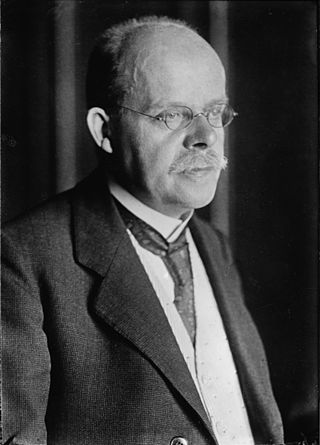
Wilhelm Marx was a German judge, politician and member of the Catholic Centre Party. During the Weimar Republic he was the chancellor of Germany twice, from 1923–1925 and 1926–1928, and served briefly as the minister president of Prussia in 1925. With a total of 3 years and 73 days, he was the longest-serving chancellor during the Weimar Republic.

The Weimar Coalition is the name given to the coalition government formed by the Social Democratic Party of Germany (SPD), the German Democratic Party (DDP) and the Catholic Centre Party (Z), who together had a large majority of the delegates to the Constituent Assembly that met at Weimar in 1919, and were the principal groups that designed the constitution of the Weimar Republic. These three parties were seen as the most committed to Germany's new democratic system, and together governed Germany until the elections of 1920, when the first elections under the new constitution were held, and both the SPD and especially the DDP lost a considerable share of their votes. Although the Coalition was revived in the ministry of Joseph Wirth from 1921 to 1922, the pro-democratic elements never truly had a majority in the Reichstag from this point on, and the situation gradually grew worse for them with the continued weakening of the DDP. This meant that any pro-republican group that hoped to attain a majority would need to form a "Grand Coalition" with the conservative-liberal German People's Party (DVP), which only gradually moved from monarchism to republicanism over the course of the Weimar Republic and was virtually wiped out politically after the death of their most prominent figure, Foreign Minister Gustav Stresemann in 1929.
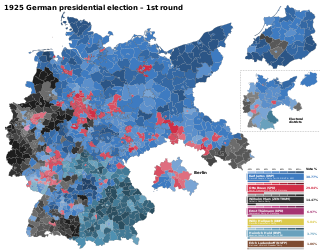
Presidential elections were held in Germany on 29 March 1925, with a runoff on 26 April. They were the first direct elections to the office of President of the Reich, Germany's head of state during the 1919–33 Weimar Republic. The first President, Friedrich Ebert, who had died on 28 February 1925, had been elected indirectly, by the National Assembly, but the Weimar Constitution required that his successor be elected by the "whole German people". Paul von Hindenburg was elected as the second president of Germany in the second round of voting.

The Free State of Prussia was one of the constituent states of Germany from 1918 to 1947. The successor to the Kingdom of Prussia after the defeat of the German Empire in World War I, it continued to be the dominant state in Germany during the Weimar Republic, as it had been during the empire, even though most of Germany's post-war territorial losses in Europe had come from its lands. It was home to the federal capital Berlin and had 62% of Germany's territory and 61% of its population. Prussia changed from the authoritarian state it had been in the past and became a parliamentary democracy under its 1920 constitution. During the Weimar period it was governed almost entirely by pro-democratic parties and proved more politically stable than the Republic itself. With only brief interruptions, the Social Democratic Party (SPD) provided the Minister President. Its Ministers of the Interior, also from the SPD, pushed republican reform of the administration and police, with the result that Prussia was considered a bulwark of democracy within the Weimar Republic.
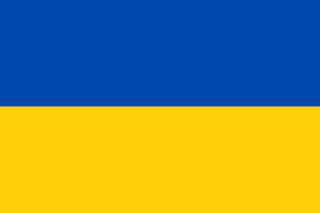
The Free State of Brunswick was a state of the German Reich in the time of the Weimar Republic. It was formed after the abolition of the Duchy of Brunswick in the course of the German Revolution of 1918–19. Its capital was Braunschweig (Brunswick). In 1933 it was de facto abolished by Nazi Germany. The free state was disestablished after the Second World War in 1946.
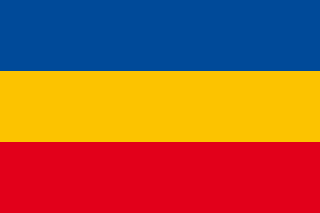
The Free State of Mecklenburg-Schwerin was a state in the Weimar Republic that was established on 14 November 1918 upon the abdication of the Grand Duke of Mecklenburg-Schwerin following the German Revolution. In 1933, after the onset of Nazi rule, it was united with the smaller neighbouring Free State of Mecklenburg-Strelitz to form the new united state of Mecklenburg on 1 January 1934.

The Weimar National Assembly, officially the German National Constitutional Assembly, was the popularly elected constitutional convention and de facto parliament of Germany from 6 February 1919 to 21 May 1920. As part of its duties as the interim government, it debated and reluctantly approved the Treaty of Versailles that codified the peace terms between Germany and the victorious Allies of World War I. The Assembly drew up and approved the Weimar Constitution that was in force from 1919 to 1933. With its work completed, the National Assembly was dissolved on 21 May 1920. Following the election of 6 June 1920, the new Reichstag met for the first time on 24 June 1920, taking the place of the Assembly.

The Ruhr uprising or March uprising (Märzaufstand) was a left-wing workers' revolt in the Ruhr region of Germany in March 1920. It initially took place in support of the call for a general strike issued by the Social Democrat members of the German government, the unions, and other parties in response to the right-wing Kapp Putsch of 13 March 1920.
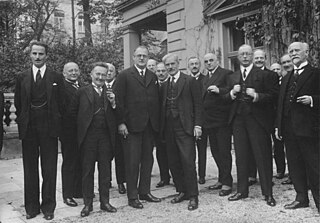
The first Müller cabinet, headed by Chancellor Hermann Müller of the Social Democratic Party of Germany (SPD), was the third democratically elected government of Germany and the second in office after the Weimar Constitution came into force in August 1919. The cabinet was based on the same three centre-left parties as the preceding Bauer cabinet: the SPD, Centre Party and German Democratic Party (DDP), a grouping known as the Weimar Coalition. It was formed on 27 March 1920 after the government of Gustav Bauer (SPD) resigned as a result of the unsuccessful Kapp Putsch, which it was seen as having handled badly.

The Fehrenbach cabinet, headed by Chancellor Constantin Fehrenbach of the Centre Party, was the fourth democratically elected government of the Weimar Republic. It took office on 25 June 1920 when it replaced the first cabinet of Hermann Müller, which had resigned due to the poor showing of the coalition parties in the June 1920 elections to the new Reichstag. The 1920 Reichstag replaced the Weimar National Assembly, which had served as Germany's interim parliament and written and approved the Weimar Constitution.

The first Marx cabinet, headed by Wilhelm Marx of the Centre Party, was the tenth democratically elected government during the Weimar Republic. It took office on 30 November 1923 when it replaced the Second Stresemann cabinet, which had resigned on 23 November after the Social Democratic Party (SPD) withdrew from the coalition. Marx's new cabinet was a minority coalition of three centre to centre-right parties.

The second Luther cabinet, headed by the independent Hans Luther, was the 13th democratically elected government of the Weimar Republic. On 20 January 1926 it replaced the first Luther cabinet, which had resigned on 5 December 1925 following the withdrawal of the German National People's Party (DNVP) from the coalition in protest against the government's support of the Locarno Treaties. Luther had wanted to build a more stable majority coalition but had to settle for a second minority government with the same parties as his first cabinet but without the DNVP.

The 1931 Prussian Landtag referendum was an attempt to prematurely dissolve the sitting session of the Landtag (parliament) of the Weimar German state of Prussia. The referendum, which took place according to Article 6 of the 1920 Prussian Constitution, was triggered by a petition launched in the spring of 1931 by the anti-republican veterans' organization Der Stahlhelm. It was supported by several right-wing parties including the Nazis, as well as by the Communist Party of Germany (KPD). Even though 93.9% of those voting on 9 August 1931 opted to dissolve the Landtag, the referendum failed because the turnout of 39.2% did not meet the minimum 50% requirement.

The third Marx cabinet, headed by Wilhelm Marx of the Centre Party, was the 14th democratically elected government during the Weimar Republic. On 17 May 1926 it replaced the second Luther cabinet after the resignation of Chancellor Hans Luther (independent) four days earlier. The Reichstag had passed a vote of censure against him for supporting a decree that permitted flying a German trade flag with the colours of the former German Empire in certain mostly overseas locations. The new Marx cabinet was a four-party centrist minority government.
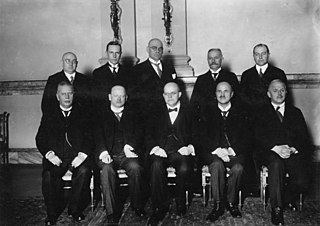
The fourth Marx cabinet, headed by Wilhelm Marx of the Centre Party, was the 15th democratically elected government during the Weimar Republic. On 29 January 1927 it replaced the third Marx cabinet, which had resigned after information concerning clandestine operations by Germany's armed forces, the Reichswehr, had come to light.
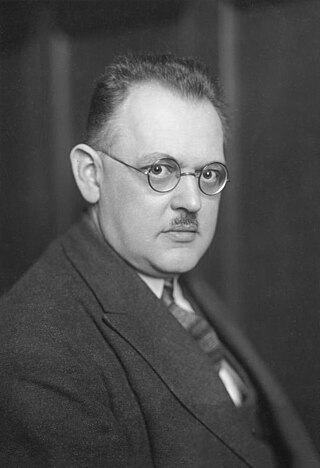
The second Müller cabinet, headed by Hermann Müller of the Social Democratic Party (SPD), was the sixteenth democratically elected government during the Weimar Republic. It took office on 28 June 1928 when it replaced the fourth Marx cabinet, which had resigned on 12 June after failing to pass a promised school law.

The first Brüning cabinet, headed by Heinrich Brüning of the Centre Party, was the seventeenth democratically elected government during the Weimar Republic. It took office on 30 March 1930 when it replaced the second Müller cabinet, which had resigned on 27 March over the issue of how to fund unemployment compensation.
References
- ↑ Luebke, David. "The Weimar Constitution: A Primer". University of Oregon. Retrieved 6 October 2022.
- ↑ "Law against the Founding of New Parties". Holocaust Encyclopedia. Retrieved 8 February 2023.
- 1 2 Carina Simon (2016). "Heinz Brauweiler: Eine politische Biographie im Zeichen des antidemokratischen Denkens" (PDF).
- ↑ "Vielparteiensystem Parteien Weimarer Republik 1918/19-1933". teachsam.de. Retrieved 2024-05-18.
- 1 2 3 4 5 6 7 8 9 10 11 "Reichstagswahlen 1919-1933 - Diverse Linke". www.wahlen-in-deutschland.de. Retrieved 2024-05-18.
- 1 2 3 "Preußen: Wahl zum 6. Reichstag 1932". www.gonschior.de. Retrieved 2024-05-18.
- ↑ "Vielparteiensystem Parteien Weimarer Republik 1918/19-1933". teachsam.de. Retrieved 2024-05-18.